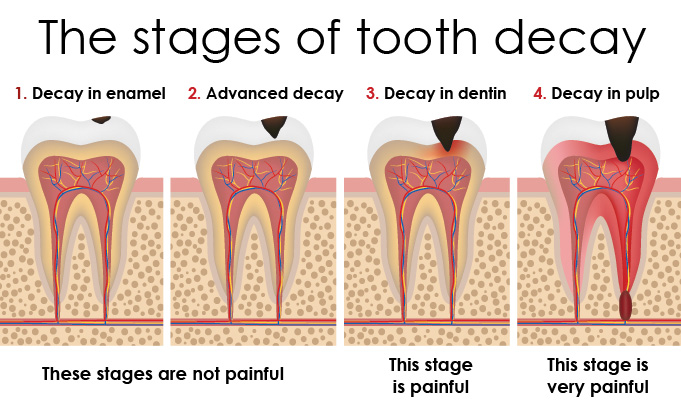While orthodontics provide treatment for aligning teeth and help create beautiful smiles, it is vital to take proper care of your teeth. One of the main issues facing teeth is tooth decay. Tooth decay, also known as cavities, are holes in the teeth that can be caused by an array of things. According to the National Institutes of Health, it is the second-most common health disorder in America, and is also very common worldwide. While typically cavities are seen in children and young adults, they can happen to anyone and at any age. Causes of tooth decay and cavities can be numerous but can be categorized by two main contributing factors: bacteria overgrowth in the mouth, and a diet laden with sugar and starches. Some bacteria are normal, but can become a problem when there is the addition of poor oral hygiene.

So how do these things contribute to the cause of cavities? When the bacteria in the mouth combines with food and saliva, plaque is formed. Plaque is a sticky, invisible film that can accumulate very quickly, and food that is high in sugar and starch makes the plaque even stickier, allowing it to better adhere to your teeth’s surfaces. When plaque is not cleaned away regularly, after a few days it hardens into tartar.
Cavities then form when the bacteria from the plaque and tartar build up convert that sugar into acid that eats and erodes your teeth. Over time, the acid creates a soft spot that then becomes a hole called a cavity. As the acid is allowed to work further into your tooth, a bigger hole grows and grows until it is treated.
Typically, there are no symptoms for early cavities. Some of the earliest symptoms can be a chalky white spot or discoloration on a tooth and sensitivity to cold. Pain and sensitivity usually happens when a cavity has gotten progressively worse. In some cases, parts of the tooth can fracture off leaving an even larger hole and sensitivity where it is exposed. Regular dental care is extremely important to detect and treat cavities before they become too problematic.
There are two ways to prevent cavities from forming in the first place: proper oral hygiene and dental care, and diet change.
To keep up with a proper oral regimen, brush your teeth at least twice a day, and have them professionally cleaned by a dentist every six months. Regular x-rays and exams yearly can also help detect cavities that may not be visible.
As far as dietary changes, limiting the amount of sugar, especially juices and sugary drinks, will help prevent cavities from forming. If you do consume sugary substances, brushing right after, or swishing with water will help keep the plaque from sticking and building up on your teeth.
Dental sealants are another option in the prevention department. They are applied to children’s teeth once their molars come in and provide a clear coating to keep the accumulation of plaque from forming.
Aside from prevention, there are several treatment options once a cavity has formed. These include: fluoride treatments, fillings, crowns, root canals, and tooth extractions.
- Fluoride is something that is done at regular dental checkups for prevention, but can also help reverse cavities in very early stages of formation. The treatment is stronger than what is in water, toothpaste, and rinses, and is typically applied through liquid, gel, foam, or varnish that is either brushed on or placed in a tray to go over your teeth.
- Fillings are also called restorations. They are the most common option for treatment of cavities when they have progressed past the earliest stages. There are several filling styles from composite resin, porcelain, or dental amalgam.
- Crowns are for more extensive tooth decay. These go over what’s remaining of your existing tooth surface and replace the natural crown. The decayed area will be drilled away before covering the rest of the tooth to ensure proper fit. They are often made of gold, porcelain, resin, porcelain fused to metal and other materials.
- Root canals are an option for tooth decay that reached the inner parts of your tooth called the pulp. This will allow you to repair and save a badly infected tooth instead of removing it. Instead of extracting the tooth, the diseased pulp is taken out. Then sometimes a medication is prescribed to help fight and clear any infection in the root. The pulp is then replaced with a filling.
- When tooth decay is too severe to be restored the tooth must come out. Once a tooth is removed it leaves a space that can cause other teeth to shift into the open space. A dental bridge or implant is often recommended to prevent shifting after an extraction.
While tooth decay can happen to anyone, with proper oral hygiene, regular dental checkups, and limited intake of sugary substances, they can be prevented!













